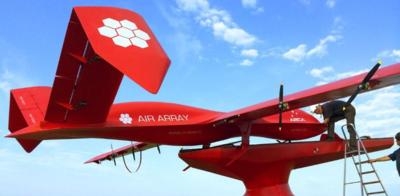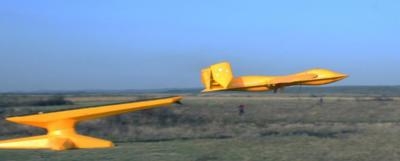Claims Performance Equivalent To Global Hawk And Predator
UAV manufacturer ArcaSpace has unveiled two UAV models that it says match the utility of Global Hawk and Predator aircraft available for the civilian market.

The company says its AirStrato has the flight ceiling of the Global Hawk, the endurance and the size of the Predator and the payload of the Shadow, at the cost of an expensive car, targeting small businesses, research institutions and even individuals as the primary market for the aircraft.
AirStrato aircraft are electric-powered, and the company says it is able to fly almost twice as high as a commercial airliner. It can be controlled from any part of the world via satellite or GSM and can takeoff and land from any remote location.
There are two AirStrato models initially available. The AirStrato Explorer, available from $140,000, is a stratospheric flying robot designed for a flight ceiling of 60,000 ft, 20 hours endurance and the capability to be controlled via satellite or GSM. AirStrato Explorer can takeoff and land from any location, no matter how remote. The Explorer has a take-off weight of 507 lb a wingspan of 52.5 ft, a length of 23.1 ft and a maximum speed of 106 mph.
The AirStrato Pioneer, available from $80,000, is a slightly smaller version of the Explorer, designed to perform flights at lower altitudes. A 26,000 ft flight ceiling, satellite control (with optional satellite communication device), and 12 hours of endurance makes Pioneer a very competitive UAV, the company says. It is more agile than the Explorer and has a higher maximum speed at low altitudes. The Explorer has a take-off weight of 485 lb, a wingspan of 39.4 ft, a length of 23.1 ft and a maximum speed of 50 mph.
Both the Explorer and Pioneer are built entirely from composite materials, are electrical powered, relying on internal batteries and solar cells. They are also equipped with recovery parachutes. The AirStrato Explorer and Pioneer are launched into the air with the Accelerator, a pneumatically driven catapult that allows the aircraft to take-off in less than a second. AirStrato is the largest air-robot in the world that is taking-off using a ground-based catapult, which makes it ideal for operations from remote areas and even from ships. The avionics are the same as are found in a modern manned aircraft. The aircraft is equipped with inertial flight stabilization and a programmable autopilot. The onboard sensors provide navigation and internal equipment status information to the flight computers. The data are then transmitted to the ground-based Interface.

The onboard ADS-B system makes AirStrato already capable to operate in the U.S. NextGeneration Air Transportation System. A VHF radio is also installed to allow communication to air traffic control or other aircraft.
The two-way transmission uses internet connection through local GSM and satellite network (an option for the Pioneer). The on-board computers automatically switches between connections if one fails, so there is always at least one connection between the aircraft and the ground pilot. The connection server has demilitarized zone protection with double firewall and Intrusion Detection and Prevention systems to block hacker intrusion. Also several servers in different locations, in US and EU are available as redundancy, that are ready to takeover the workload in case one ore more servers encounter denial of service attacks.
ARCA says the AirStrato Explorer and Pioneer applications can include: border protection, both land and sea; disasters monitoring and management; contaminated areas monitoring; remote areas exploration, as arctic areas, ocean, mountains, forests, deserts; rescue missions; military reconnaissance; oil pipes and power lines monitoring; communication relay; high atmosphere scientific research; meteorology; auto and maritime traffic control; TV and cinema; internet delivery network over remote areas; or just flying for entertainment.
The price range for the AirStrato products is between $80,000 and $140,000. Production is estimated to begin in March 2015 for Pioneer and in August 2015 for Explorer.
(Images provided by ARCASpace)
 Airborne-Flight Training 05.09.24: ERAU at AIAA, LIFT Diamond Buy, Epic A&P
Airborne-Flight Training 05.09.24: ERAU at AIAA, LIFT Diamond Buy, Epic A&P ANN's Daily Aero-Term (05.07.24): Hazardous Weather Information
ANN's Daily Aero-Term (05.07.24): Hazardous Weather Information Aero-News: Quote of the Day (05.07.24)
Aero-News: Quote of the Day (05.07.24) NTSB Final Report: Cessna 150
NTSB Final Report: Cessna 150 Aero-News: Quote of the Day (05.08.24)
Aero-News: Quote of the Day (05.08.24)




